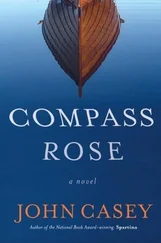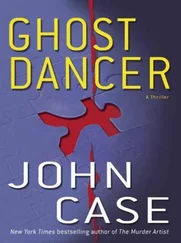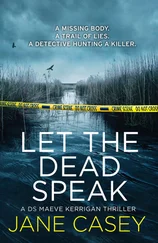Dick switched on the chart light and got a loran reading. Good enough, rolling right along.
By midnight he was getting a little tired. The swells, still farther apart than any he’d ever run into, were bigger now. He couldn’t see them very well, but he felt them as Spartina took them on her starboard bow, chugged up them slowly and then slid over the top with a little pitch and roll.
After an hour he checked his position again. The swell had slowed Spartina considerably.
He called the Lydia P. , got Captain Texeira’s nephew. Their position was well east of Spartina ’s. The hurricane had grown. Lydia ’s satellite picture showed that the two systems had linked up and had picked up some speed. The storm center was more than two hundred miles off Cape Hatteras and moving due north at about thirty-five knots, maybe more. If she didn’t curve, she would plow into New England somewhere between Old Lyme and the middle of Cape Cod. The Rhode Island shore was the bull’s eye between those two points.
It looked as though Captain Texeira had made a good guess and a good move. Dick saw that Spartina wasn’t in quite as good a position. The diameter of the hurricane was now almost four hundred miles. If she hit dead on the mouth of Narragansett Bay, Spartina would have to be at least two hundred miles to the east. Since midnight Spartina ’s progress eastward was down to six knots. There was no wind to speak of but cutting across the swell was like mountain climbing. If the forward edge of the hurricane was now pushing past Hatteras at thirty-five to forty knots, it would reach Spartina in ten or eleven hours. Spartina would be, at best, 120 miles east of the eye. She’d get caught. Not in the fiercest winds — those were tucked in tight swirls around the center. But even halfway out to the edge, according to the reports that the Lydia P. had, the winds were full hurricane force, and since Spartina was going to be in the eastern sector of the storm, where the counterclockwise swirl was blowing in the same general direction as the overall movement of the hurricane, he could add those forty knots to the force of the wind.
If the two storm centers hadn’t linked up, he’d have been in dandy shape. Neither storm by herself had been bigger than 150 miles in diameter, and Spartina would have been forty to fifty miles east of the eastern edge. Sure — rough seas, some gale-force wind, but nothing to worry about. But now that the hurricane had doubled up, the eastern edge was reaching out for Spartina like a big paw.
Another problem Dick foresaw was that, if he was pushed too far north by the southeast wind, he’d end up over Georges Bank. It was almost as bad as a lee shore. The waves, as they felt the tug of the rising bottom of Georges Bank, would bunch up, grow steeper, break.
Dick had been at the wheel of a Coast Guard vessel in ’59, winds at just hurricane force. At half-power, bow into the wind, she’d still been moving backward. If everything the Lydia P. reported was correct, Spartina was in for winds some forty knots harder. Dick couldn’t calculate the force exactly. He’d read that the force of the wind increased not just with the velocity of the wind, but with the square of the velocity. So a sixty-knot wind pushed at about fifteen pounds a square foot, but a 120-knot wind pushed not at thirty pounds but at almost eighty pounds a square foot.
If Spartina caught a wind like that broadside, it would be like being pushed by a tugboat the same size as her.
Dick looked at the chart. It was easy, on paper, just looking at numbers and lines. Spartina laboring eastward at six knots. The hurricane boiling northward at forty knots — right along 71°30’, as though it was a rail. He could hope the storm would slow down. If she slowed to thirty knots, he’d get out almost to her eastern edge. If she slowed to twenty knots, he’d be able to slip beyond her reach. Right out there with Captain Texeira’s lucky ships, even now the Bom Sonho headed toward the Azores, the stars shining on her.
Dick checked with the Lydia P. every couple of hours. The hurricane was still coming at full speed, straight as an express train. The distance between the Lydia P. and Spartina was now greater than could be accounted for by their different hull speeds. It was the size of the swells that was cutting Spartina ’s way.
At what should have been sunrise, light began to ooze through the cloud cover, an amber glow with tinges of green. The swell, now visible, was enormous. Every time Spartina reached a rounded crest, Dick could see three or four crests to the south. The swell seemed almost stationary, foothills of a mountain range.
At ten o’clock he checked the barometer. Twenty-eight. He was about to call the Lydia P. once more when he looked to the south. He didn’t need to call. He could see the abrupt line where the amber glow of the cloud cover and round swell gave way to darkness. And yet in the darkness there was a flickering. At first he thought it might be lightning, then he thought it might be whitecaps catching the last light. Before he got close enough to decide, his visibility dropped.
He was scared, but his fear seemed remote from his body. He drank a Coke and ate a Hershey bar. He took out another Hershey bar but left it in its white inner wrapper in his jacket pocket. He turned on the pump and put some more sea water in the lobster wells. He hooked the door to the wheelhouse open and ran a twist of wire around the hook and eye. One thing he didn’t need was to pop the windows out when the pressure dropped.
When the first wind hit, he watched the needle on the dial of the anemometer. It spurted up to seventy and then fell off as Spartina slid into a trough. He eased back on the throttle. The seas were steeper than the swell had been, but not as high. The peaks were blown flat by the wind. He caught the anemometer dial out of the corner of his eye. The needle flung itself all the way to the right. Spartina moved nicely into the next trough, and Dick eased up even more on the throttle. He couldn’t see anything beyond the bow except water. He had no sense of its movement, whether it was coming at him or whether it was rising or falling. He felt Spartina rise. He watched the needle spurt to the right and then fall back. He was puzzled for an instant, but then felt Spartina nosing down into the dark of the next trough.
From the noise of the wind and the quick scribblings of spray across the glass in front of him it seemed he was engulfed in speed, but the one true sense he had — hearing and sight conveying no meaning — was of slow motion.
He caught a glimpse of the anemometer needle slack at zero. He realized the cups had blown off.
He checked her depth. Plenty of water under her.
He broke off a bit of chocolate every half-hour. Then he realized he was making time drag on him by checking his watch. He saved the last bit of chocolate for a lull.
It struck him as odd that his legs got tired before his arms did. And as his calves and thighs began to bother him with twinges, his confidence weakened. He felt tired and stupid and unlucky.
There came a lull. For a terrible moment he feared it was the eye. The eye would be a disaster. It would mean the storm had curved out to sea toward him. It would mean that the winds yet to come would be violently opposed to how the sea was running, Spartina would be caught in confused seas, freak waves. But it was just a lull. The wind still southeast as far as he could tell, Spartina tucked into the lee of the mountainous seas. In his momentary panic he’d forgotten to eat the rest of his Hershey bar. In the next trough he mashed it into his mouth and got both hands back on the wheel. When Spartina was deep in the trough, the windshield wasn’t lashed with spray. He could make out just enough of the hole he was in to see Spartina as a bug in a toilet bowl.
Читать дальше












